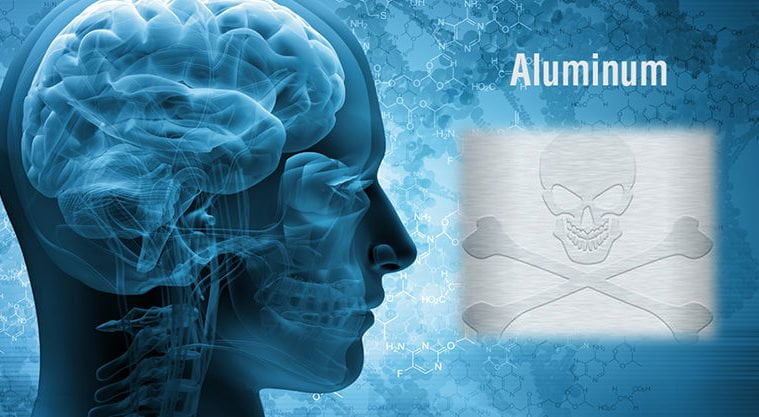
Scientists have been aware of aluminum’s neurotoxicity for decades. Although aluminum’s apologists have tried to shroud the metal’s risks in manufactured controversy, a growing number of reports by researchers in the United Kingdom, France, Canada, Israel, the U.S. and elsewhere has furnished substantive evidence linking aluminum to neuropathology, including the epidemics of Alzheimer’s disease (AD) and autism spectrum disorder (ASD).
Dr. Christopher Exley—one of the world’s leading experts on aluminum toxicity—has shown that chronic intoxication with myriad forms of this “ubiquitous and omnipresent metal” is exacting a high price on human health. Dr. Exley and other aluminum experts such as molecular biologist Dr. Lucija Tomljenovic have confirmed that aluminum readily and actively traverses the blood-brain barrier to selectively accumulate in brain tissues, where it induces unwelcome changes in brain biochemistry. As Dr. Exley has noted, “There are no ‘normal’ levels of brain aluminum,” meaning that “its presence in brain tissue, at any level, could be construed as abnormal” [emphasis added].
Below is a video of him speaking on his study.
Documenting Aluminum in the ASD Brain
In light of the fact that even minute amounts of aluminum can have adverse neurological consequences, Dr. Exley’s newest paper—which reports on the first-ever study of aluminum in ASD brain tissue—is groundbreaking. Published in the Journal of Trace Elements in Medicine and Biology, the paper documents some of the highest values for aluminum in human brain tissue ever recorded. Using a two-pronged study design (see box), the researchers measured and characterized aluminum deposits in brain tissues from five to ten ASD donors, most of whom died in their teens or twenties.
| Study DesignQuantitative component: First, the investigators used graphite furnace atomic absorption spectrometry (GRAAS) to measure aluminum content in frozen brain tissue samples. Frozen tissue was available from one female donor (age 44) and four male donors (ages 15, 22, 33 and 50) who, when alive, had a confirmed ASD diagnosis. The researchers quantified aluminum levels in 59 tissue samples representing five different areas of the brain (frontal, parietal, occipital, temporal and hippocampal).Qualitative component: Using a technique called fluorescence microscopy, the researchers visualized aluminum deposits according to their presence (a) insideversus outside the brain cells and (b) in the two types of brain tissue (grey matterversus white matter). For this component, fixed tissue samples were available for the same five donors plus an additional five donors diagnosed with ASD, including two females (ages 13 and 29) and three males (ages 14, 22 and 29). |
What the research team found was startling. The study’s quantitative arm documented “consistently high” aluminum levels representing “some of the highest values for brain aluminum content ever measured in healthy or diseased tissues.” Specifically:
- All five individuals had at least one brain tissue with a “pathologically significant” level of aluminum, defined as greater than or equal to 3.00 micrograms per gram of dry brain weight (μg/g dry wt). (Dr. Exley and colleagues developed categories to classify aluminum-related pathology after conducting other brain studies, wherein older adults who died healthy had less than 1 μg/g dry wt of brain aluminum.)
- Roughly two-thirds (67%) of all the tissue samples displayed a pathologically significant aluminum content.
- Aluminum levels were particularly high in the male brains, including in a 15-year-old boy with ASD who had the study’s single highest brain aluminum measurement (22.11 μg/g dry wt)—many times higher than the pathologically significant threshold and far greater than levels that might be considered as acceptable even for an aged adult.
- Some of the elevated aluminum levels rivaled the very high levels historically reported in victims of dialysis encephalopathy syndrome (a serious iatrogenic disorder resulting from aluminum-containing dialysis solutions).
The study’s qualitative findings were equally concerning:
- Across the 10 donors, the investigators identified 150 aluminum deposits. All 10 donors had aluminum deposits in at least one tissue.
- Aluminum deposits were markedly more prevalent in males than females (129 deposits in seven males, averaging over 18 deposits each, versus 21 deposits in three females, for an average of 7).
- In males, most aluminum deposits were inside cells (80/129), whereas aluminum deposits in females were primarily extracellular (15/21). The majority of intracellular aluminum was inside non-neuronal cells (microglia and astrocytes).
- Aluminum was present in both grey matter (88 deposits) and white matter (62 deposits). (The brain’s grey matter serves to process information, while the white matter provides connectivity.)
- The researchers also identified aluminum-loaded lymphocytes in the meninges (the layers of protective tissue that surround the brain and spinal cord) and in similar inflammatory cells in the vasculature, furnishing evidence of aluminum’s entry into the brain “via immune cells circulating in the blood and lymph” and perhaps explaining how youth with ASD came to acquire such shockingly high levels of brain aluminum.
The Importance of Glial Cells
There are three broad categories of non-neuronal (glial) cells, including astrocytes (which support neuronal signaling), oligodendrocytes (which create myelin) and microglia (responsible for repairing damage). In discussing their results, Dr. Exley’s team comments that the intracellular location of most of the aluminum in these non-neuronal cells was the “standout observation” for ASD.
Unlike other brain cells, the microglia (which represent about 10% of brain cells) are dedicated immune cells. Microglia also play a key role in the process known as synaptic pruning that takes place during vital phases of cognitive development in early childhood as well as adolescence, continuing into the late 20s. This process, which some observers have likened to “neural spring cleaning,” allows the maturing brain to shed “weak or redundant [neuronal] connections.” Given this and other important microglial functions, the microglia have attracted considerable research attention as key players in brain disease, including autism. (Astrocytes also have implications for autism, given the role of astrocyte dysfunction in seizures—a condition that is frequently comorbid with ASD.) A pivotal review article published in 2017 observes that “microglia are now known to be active participants in brain function and dysfunction” and notes that “aberrant [synaptic] pruning during critical developmental periods could contribute to neurodevelopmental disorders.” Evidence suggesting that the microglia are dysfunctional in ASD includes findings from postmortem ASD brain studies showing “altered microglial counts, morphology, and neuronal interaction” as well as altered expression of microglia-specific genes.
The Most Pervasive Exposure to Aluminum
The study’s results strongly suggest that aluminum is entering the brain in ASD via cells that have become loaded up with aluminum in the periphery. Where is the aluminum coming from? One of the most pervasive routes of modern-day exposure to neurotoxic aluminum is via aluminum adjuvants in vaccines. (Vaccine manufacturers use aluminum adjuvants to intensify the vaccine recipient’s immune response.) Elsewhere, Dr. Exley has described the “migratory capabilities” of aluminum-based adjuvants “at sites distant to the injection site,” including the brain.
In the ASD brain paper, Dr. Exley and coauthors point out that the “burgeoning” use of aluminum-adjuvant-containing childhood vaccines “has been directly correlated with increasing prevalence of ASD.” A 2011 study by Lucija Tomljenovic and Christopher Shaw confirms that aluminum-containing vaccines are having crippling neurological consequences. Their analysis shows that children from countries where ASD prevalence is highest have the highest exposure to aluminum from vaccines; moreover, children’s increased exposure to aluminum adjuvants over the two decades starting in the 1990s significantly correlates with the increase in ASD prevalence in the U.S. Counting the shots now pushed during pregnancy, highly vaccinated American children may receive up to 73 total vaccine doses by age 18, including multiple rounds of injected aluminum.
U.S. vaccines containing one or more aluminum adjuvants*
| Infection or Illness | Vaccine | Manufacturer or Brand Name |
| Diphtheria-tetanus or tetanus-diphtheria | DT Td | Sanofi Tenivac; Mass Biologics |
| Diphtheria-tetanus-pertussis or tetanus-diphtheria-pertussis | DTaP Tdap | Daptacel; Infanrix Adacel; Boostrix |
| Haemophilus Influenzaetype B | Hib | PedvaxHib |
| Hepatitis A | Hep A | Havrix; Vaqta |
| Hepatitis B | Hep B | Engerix-B; Recombivax |
| Human papillomavirus | HPV | Gardasil; Gardasil 9 |
| Meningitis | Meningococcal | Bexsero |
| Streptococcus pneumoniae | Pneumococcal | PCV 13/Prevnar 13 |
| Combination vaccines | DTaP-IPV DTaP-HepB-IPV DTaP-IPV/Hib Hep A/Hep B | Kinrix; Quadracel Pediarix Pentacel Twinrix |
* Aluminum hydroxide, aluminum phosphate, aluminum salts, amorphous aluminum hydroxyphosphate sulfate (AAHS), potassium aluminum sulfate
Crucially, Dr. Exley and coauthors note that what “discriminates [their] data from other analyses of brain aluminum in other diseases is the age of the ASD donors” [emphasis added]. The extreme levels of aluminum found in the brains of the study’s teenage donors have alarming implications for the entire generation of highly aluminum-vaccinated children. Moreover, Dr. Exley’s other research has consistently shown that aluminum is the most significant contributing factor to Alzheimer’s disease. Given that it is no longer unheard of to see Alzheimer’s being diagnosed in people who are in their 20s, 30s, or 40s, it is not unreasonable to worry that a catastrophic new wave of AD may be about to compound children’s already heavy burden of ASD and other neurological disorders. Recognizing the risks, numerous researchers have called for a halt to the use of aluminum salts in vaccines. The powerful results of this study underscore the urgency of heeding this plea as well as eliminating exposure to other sources of neurotoxic aluminum.
Disclaimer: We at Prepare for Change (PFC) bring you information that is not offered by the mainstream news, and therefore may seem controversial. The opinions, views, statements, and/or information we present are not necessarily promoted, endorsed, espoused, or agreed to by Prepare for Change, its leadership Council, members, those who work with PFC, or those who read its content. However, they are hopefully provocative. Please use discernment! Use logical thinking, your own intuition and your own connection with Source, Spirit and Natural Laws to help you determine what is true and what is not. By sharing information and seeding dialogue, it is our goal to raise consciousness and awareness of higher truths to free us from enslavement of the matrix in this material realm.
Français
 EN
EN FR
FR


























I still can not understand how people continue to sell liquids in aluminum containers. and how babies, children and adults are still being vaccinated ..
This is a very good information and I would like everybody take it and share it.
Thank you Edward.